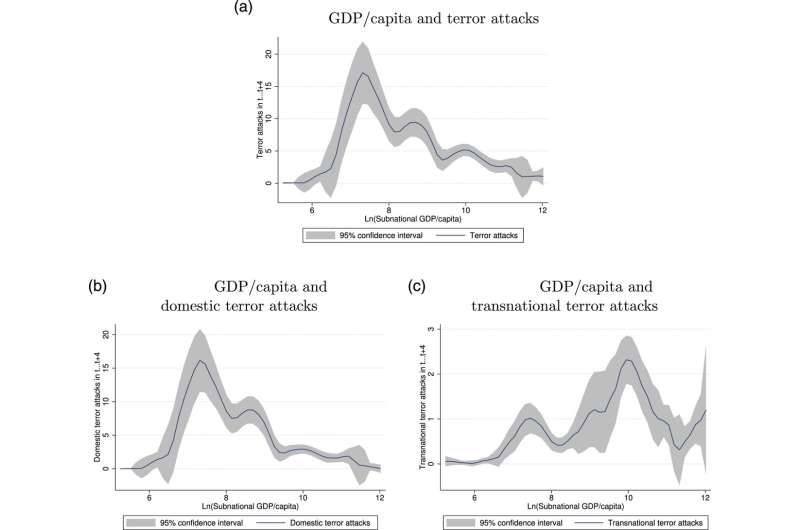This article has been reviewed according to Science X's editorial process and policies. Editors have highlighted the following attributes while ensuring the content's credibility:
fact-checked
trusted source
proofread
Links between income and terrorism found to follow the same pattern globally

Rising incomes in the world's poorer countries weaken terrorism: many political decision-makers have been convinced of this since the attacks of September 11, 2001. However, a study by Bayreuth economist Prof. Dr. David Stadelmann published in the Journal of Conflict Resolution puts this view into perspective.
Together with research partners in Abu Dhabi/UAE and Perth/Australia, he demonstrates that an increase in income in poorer countries is initially accompanied by an increase in terrorist activity. Only when average incomes reach a level of around $12,800 do further increases in income go hand in hand with a sustained weakening of terrorism.
The conclusion of the study is that societies in poorer countries worldwide must expect an increase in terrorist activities and not a decrease when economic conditions begin to improve as a result of economic growth. Significant economic growth should therefore be accompanied in its early stages by more intensive monitoring of potential terrorist groups and, if possible, counterterrorism strategies.
"We hope that our analyses will encourage policymakers at the regional, national, and international levels to further explore the relationship between economic progress and terrorism. For a very long time, the view that rising incomes and an accompanying increase in living standards would, as it were, automatically reduce the risk of terrorist attacks has influenced political and social decisions. But the situation is more complex," says Prof. Dr. David Stadelmann, who is Chair of Economic Policy and Economic Development at the University of Bayreuth.
Empirical data from over 1,500 regions of the world
The authors of the study first developed a theoretical framework based on the current state of research in order to formally represent and analyze correlations between the level of terrorist activity and income trends among the population. Building on this, they constructed a database that is special in its breadth: it contains empirical data from the years between 1970 and 2014 for 1,527 regions in 75 countries that are broadly representative of the global relationship between income and terrorism.
In particular, these data relate to the frequency and motives of terrorist attacks as well as the standard of living of the population in the various regions. Using statistical methods, factors that are constant over time are also included, such as specific geographic, historical, or enduring cultural conditions that may be positively or negatively related to terrorist activity.
The 'inverted U shape' as a basic global pattern
Despite all the differences, a clear basic pattern emerges. It is described by the authors as an "inverted U-shape." Almost everywhere, an increase in incomes is initially accompanied by an increase in the frequency and intensity of terrorist activity until a tipping point is reached. From then on, a further rise in incomes is associated with a continuous weakening of terrorism.
The tipping point, the calculations show, is reached when the increase in annual incomes reaches an average of $12,800 per capita. "The fact that the inverted U-shape has emerged as a basic pattern in more than 1,500 regions of the world shows very clearly that there is a significant correlation between income levels and terrorism globally," Stadelmann explains.
More precise findings through comparisons of subnational regions
The authors emphasize that the relationship between income levels and terrorism can be more accurately inferred by examining selected subnational regions such as Île-de-France, Catalonia, Baluchistan or California—instead of entire countries like France, Spain, Pakistan and the United States.
This method is more accurate for two reasons: terrorist attacks often concentrate in one region rather than spreading evenly across the country. In Chile, for example, the O'Higgins region was spared terror from 1970 to 2014, while the data used for the Santiago metropolitan region show 1,612 attacks. In addition, income differences between regions are often greater than between countries.
For example, the average income in Moscow is higher than in Sicily, although the population in Italy is on average about three times wealthier than in Russia. Such differentiations are lost in studies that limit themselves only to country comparisons.
Politically and religiously motivated terrorism
The study also includes the question of whether political or religious ideologies motivating terrorist attacks influence the relationship between income and terrorism. The researchers distinguish between left-leaning, right-leaning, separatist, Islamist and other religious groups.
The analyses show that religiously motivated terrorism tapers off earlier than left- or right-wing terrorism when incomes rise continuously. For such politically motivated forms of terrorism, the tipping point does not set in until somewhat later, when higher income levels are reached. Overall, however, the inverted U-shape is found in all variants of terrorism—however they are ideologically shaped.
More information: Michael Jetter et al, Income and Terrorism: Insights From Subnational Data, Journal of Conflict Resolution (2023). DOI: 10.1177/00220027231175071
Provided by Bayreuth University



















